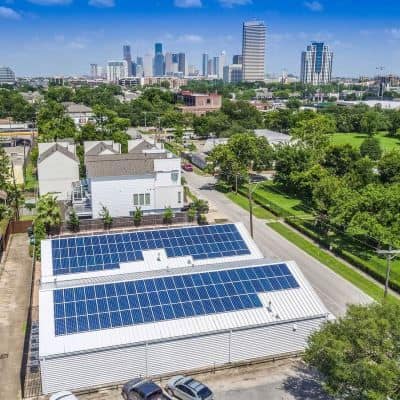Episode 21 | October 9, 2018
Texas Energy Topics, Part Two. In the first part of our conversation with Paul Hobby of Genesis Park LP, we talked about Houston post-Harvey and how energy is inseparable from business and life in Texas. This week, Paul explains the Texas electricity market structure, predicts the future of energy prices, and hypothesizes that low natural gas prices may be doing more for wind and solar power innovation than renewable energy subsidies.
Hosts Kyle Frazier and Sherren Harter, along with guest host Bret Biggart from Freedom Solar, get Paul’s perspective on multiple topics related to the Texas electricity market, including wind and solar power. Below are the highlights from the conversation, presented in a question-and-answer format (edited for clarity and length).
Why did you choose solar panels?
I always thought that solar was just cool. It’s sort of God mocking us when we talk about an energy crisis. Actually we’re inundated with solar radiation all day every day and so we’ve got all the energy we want, and there’s this incredibly simple process to convert it called photovoltaic effect, at least when you’re talking about silicon-based cells. So I’ve always thought it was just sort of receiving nature’s bounty, and it lowers your bill too so that’s pretty cool.
What do the economics need to look like for solar power to succeed?
From a business point of view a 4 or 5 year payback is fine. Individual consumers may be driven by cash constraints, financing options, and psychological factors that no one has entirely worked out yet.
Renewable subsidies have worked, but we don’t need them anymore. Solar and wind are incredibly competitive on a levelized cost of electricity basis. You still need a storage device. Most renewable sources other than hydro are intermittent. So that’s simply an engineering challenge we can solve. I think solar is fabulous – it’s clean, it’s cool, it’s self-contained, and it’s getting cheaper all the time.
Wind is becoming more efficient faster than solar is, but solar is still continually getting more efficient and more competitive, with the price of solar in municipal requests for proposal (RFP) dropping by one-third in the past five years. The more interesting question is, but for cheap shale gas, would wind and solar be more expensive? They’ve been forced to be innovative and cheaper, so in its own way low natural gas prices have been a blessing for renewable energy.
What is the future of the cost of energy in Texas over the next 10 years?
Texas energy prices are going to be very flat. There will not be significant capital investments. The biggest effect on the price of retail electricity is the forward price of natural gas – the marginal MMBTU always sets the price for the marginal electron. And everybody’s forward curve (predicted price of natural gas in the future) is flat.
Where would you invest funds in the solar power industry?
My advice would be to not play in the retail or wholesale game. I think application-specific renewable energy – solar pool heaters, for example – is more exciting. The solar thermal effect is a more natural application than solar photovoltaic because it does what sunlight does best without a lot of manipulation – it heats water. Another example would be using the solar power for water distillation or heat exchange. Harvesting waste heat from heat sources such as washing machines or steam tunnels to create electricity is a great idea.
Will Austin and San Antonio ever deregulate their electricity markets?
No, I think that Austin will continue to be the people’s republic that it wants to be.
Texas has one of the more complicated electricity markets, with three distinct market structures that each have trade-offs:
1. Non-ERCOT
2. Municipally owned utilities and cooperatives
3. Rest of Texas is a completely unregulated merchant environment
In the city-owned utilities of Austin and San Antonio, the good news is you don’t have excessive corporate debt issues, low cost of borrowing, no shareholder dividends or public company CEO prices. The downside is that generating plants don’t pay property taxes, which generally pay for schools. Any comparison of the regulated and deregulated markets should factor in variables such as property taxes.
What are the threats to the electricity industry?
The grid has value. We can be more autonomous than we once were and have more generation behind the panel, and those are good things. However, the grid serves a good and useful purpose. It’s important, it must be kept resilient, and it’ll be here forever. It’s a marvel of engineering.
What the electricity industry is worried about is the master retailers Amazon and Google. The reason they are interested in a perishable commodity that has so little retail value that TXU and Reliant give it away on the weekends is because of the vast information they can collect about your household. Your power provider if it has the right kind of intelligence on the return signal knows a lot about what you’re doing and when you’re doing it.
What does your future hold?
I’m just a guy trying to leave things better than I found them, whether it’s a government agency, my church or school, my business, or a non-profit. As with Texas Monthly, I’m just trying improve the things I’m associated with, and like everybody else I want them to matter.
